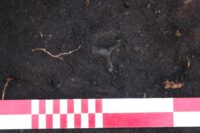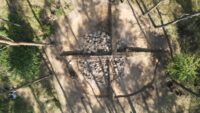Polish archaeologists have discovered the remains of an ancient cremation grave under a uniquely-constructed burial mound in the Sarbia forest area of northwest Poland.
The mound is the easternmost in a line of kurgans that are part of a necropolis of the Iron Age Wielbark culture (1st-5th century A.D.) near the village of Mirosław. The excavation revealed the mound was built over an interior stone pavement encircled by two trenches and a ring of wooden posts reinforced with clay walls.
Underneath the pavers is a levelling layer with an impressive range like a stone shim, starting on the east side with a height of six inches and ending on the west side at almost 20 inches high. This strong structure ensured that the tons of stone piled on it to build the kurgan mound would not collapse. Archaeologists believe there were additional elements — wood or clay structures — reinforcing the mound from the other side.
 The cremation burial was found inside the leveling layer. It was dug into the center of the square pavement and contains only human remains and one iron spur. Wielbark burials, cremation and inhumation, do not contain weapons or armor. Spurs are the only attributes of warrior burials ever found in Wielbark graves, and even they are rare.
The cremation burial was found inside the leveling layer. It was dug into the center of the square pavement and contains only human remains and one iron spur. Wielbark burials, cremation and inhumation, do not contain weapons or armor. Spurs are the only attributes of warrior burials ever found in Wielbark graves, and even they are rare.
The remains of a person buried here are currently the subject of anthropological research conducted by prof. M. Krenz-Niedbała at the Faculty of Biology, AMU. The temperature of the cremation stack must have been unusually high. This is evidenced by the state of burning human bones, but also small teardrops of metal from grave gifts. The only object that has been preserved in its entirety is a bronze spur, so we can assume that again in the area of the examined cemetery we are dealing with a rider’s grave (or maybe, as was the case in the 2020 season – amazons). Among the damaged pieces of equipment, a fragment of the clasp bow and perhaps a fragment of a S-shaped clasp have survived. After the conservation of the monuments, we will certainly learn more about their function — adds [Andrzej Michałowski, Dean of the Faculty].
Near the grave, from the east, as was the case under the embankment of the 7th burial mound examined in 2016, a trace of the bottom of the iron firing furnace was recorded. Nearby, during the works carried out in the area of the embankment, there were iron slags, probably coming from the basin that had been dismantled before the construction of the burial mound.
